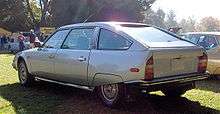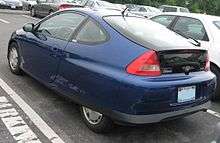Kammback

A Kammback — also known as "Kamm tail" or "K-tail" — is an automotive styling feature where the rear of the car slopes downwards before being abruptly cut off with a vertical surface. The purpose of a Kammback is to minimise aerodynamic drag while maintaining a practical shape for a vehicle. The Kammback is named after German aerodynamicist Wunibald Kamm for his work developing the design in the 1930s.
The Kammback was originally used on sports cars and racing cars to improve performance at high speeds, and has been more recently used by hybrid vehicles to reduce fuel consumption.
Origins
.jpg)
.jpg)
As the speed of cars increased during the 1920s and 1930s, designers began to pay more attention to automotive aerodynamics.[1] In 1922, Paul Jaray patented a car based on a tear-drop profile (i.e. a rounded nose and long tapering tail) to minimise the aerodynamic drag created at higher speeds.[2][3] The streamliner vehicles of the mid 1930s — such as the Tatra 77, Chrysler Airflow and Lincoln-Zephyr — were designed according to this philosophy.
However, the long tail was not a practical shape for a car, so automotive designers were looking for other solutions. In 1935, the German aircraft designer Georg Hans Madelung showed alternatives to minimise drag without a long tail.[4] In 1936, a similar theory was applied to cars, when Baron Reinhard Koenig-Fachsenfeld developed a smooth roofline but with an abrupt end at a vertical surface, which was effective in achieving low amounts of drag similar to a fully streamlined body.[3][5][6] He worked on an aerodynamic design for a bus, and Koenig-Fachsenfeld patented the idea.[7] Koenig-Fachsenfeld began working under Wunibald Kamm at Stuttgard University, investigating vehicle shapes that would "provide a good compromise between everyday utility (e.g. vehicle length and interior dimensions) and an attractive drag coefficient".[3][5] In addition to aerodynamic efficiency, Wunibald Kamm also emphasized vehicle stability in his design.[5] He proved mathematically and empirically the effectiveness of the design.[8]
In 1938 Kamm produced the first prototype to use a Kammback, based on a BMW 328.[9] The Kammback, along with other aerodynamic modifications, gave the prototype a drag coefficient of 0.25.[10]
The earliest mass-produced cars that used Kammback principles were the 1949–1951 Nash Airflyte in the U.S. and the 1952–1955 Borgward Hansa 2400 in Europe.[5]
Aerodynamic theory
The ideal shape to minimize drag is a teardrop. However researchers including Kamm found that abruptly cutting off the tail resulted in minimal increase in drag.[3] The reason for this is that a turbulent wake region forms behind the vertical surface at the rear of the car. This wake region mimics the effect of the tapered tail in that air in the free stream does not enter this region (avoiding boundary layer separation), therefore smooth airflow is maintained which minimises drag.[9]
Kamm's design is based on the tail being truncated at the point where the cross section area is 50% of the car's maximum cross section,[3][11] which Kamm found represented a good compromise—by that point the turbulence typical of flat-back vehicles had been mostly eliminated at typical speeds.
Usage
.jpg)


_liftback_(2011-12-06)_02.jpg)
Initially, the Kamm tail was used on sportscars and racing cars. The design had a resurgence in the early 2000s as a method to reduce fuel consumption in hybrid electric vehicles.
Several cars have been marketed as Kammbacks, despite the profile not adhering to aerodynamic philosophy of a Kammback. These models include the 1971–1977 Chevrolet Vega Kammback wagon,[12] the 1981–1982 AMC Eagle Kammback,[13][14][15][16] the AMC AMX-GT and the Pontiac Firebird–based "Type K" concept cars.[17][18][19][20][21]
Cars that have a Kammback include:
- 1940 BMW 328 "Mille Miglia" Kamm coupé[22][23]
- 1952 Cunningham C-4RK
- 1961 Ferrari 250 GT SWB Breadvan
- 1962–1964 Ferrari 250 GTO
- 1963 Aston Martin DP215
- 1963–1974 Bizzarrini Iso Grifo[24]
- 1965–1971 Aston Martin DB6[25]
- 1965–1968 Ford GT40[26]
- 1965–1970 Aston Martin DB6
- 1966-1974 Saab Sonett II and III[27]
- 1968–1973 Ferrari 365 GTB/4 ("Daytona")
- 1968–1976 Ferrari Dino[28]
- 1969–1971 Fiat 850 Coupe and Sport Coupe
- 1970–1975 Citroën SM
- 1970–1977 Alfa Romeo Montreal
- 1970–1986 Citroën GS[29]
- 1970–1978 Datsun 240Z, 260Z, 280Z
- 1971–1989 Alfa Romeo Alfasud[29]
- 1971–1973 Ford Mustang Fastback[30]
- 1972–1982 Maserati Khamsin
- 1974–1991 Citroen CX
- 1985-1995 Autobianchi Y10 / Lancia Y10
- 1991–1998 Mazda MX-3
- 1994–1998 Mazda Familia Neo/323C
- 2000–2006 Honda Insight[31]
- 2004–present Toyota Prius[32]
- 2010–2014 Honda Insight (2nd generation)[33]
References
- ↑ Hucho, Wolf-Heinrich (1987). Aerodynamics of Road Vehicles: from fluid mechanics to vehicle engineering. Butterworths. pp. 19–20. ISBN 978-0-408-01422-9.
- ↑ "Paul Jaray 1889-1974". Coachbuilt.com. Retrieved 9 June 2014.
- 1 2 3 4 5 Ziemnowicz, Christopher (2004). "The Origin of the Kammback Design". Archived from the original on 15 April 2012. Retrieved 9 June 2014.
- ↑ Gowans, Alan (1981). Learning To See: Historical perspective on modern popular/commercial arts. Popular Press 1. p. 360. ISBN 978-0-87972-182-4.
- 1 2 3 4 Eckermann, Erik; Albrecht, Peter L. (2001). World History of the Automobile. SAE International. pp. 115–117. ISBN 978-0-7680-0800-5. Retrieved 9 June 2014.
- ↑ Ludvigsen, Karl (Fall 1967). "Automobile Aerodynamics: Form and Fashion". Automobile Quarterly. 6 (2).
- ↑ Montgomery, Bob (8 August 2007). "Designing a spin for the tail end of things" (fee required). The Irish Times. Retrieved 8 December 2011.
- ↑ Bush, Donald J. (1975). The streamlined decade. George Braziller. p. 109. ISBN 978-0-8076-0793-0.
- 1 2 Taylor, Rich (September 1981). "Searching for the Perfect .10". Popular Mechanics: 158. Retrieved 9 June 2014.
- ↑ Ihrig, Ron (3 December 2004). "Part 3: Production, Physics, Politics - Only the Strong Survive - German Design History". Car Design News. Archived from the original on 22 July 2012. Retrieved 9 June 2014.
- ↑ "Kamm Back". Auto Repair About. Retrieved 9 June 2014.
- ↑ Stevenson, eon (2008). American automobile advertising, 1930-1980: an illustrated history. McFarland. p. 221. ISBN 9780786452316. Retrieved 9 June 2014.
- ↑ "History of the 1981 AMC Eagle". AMC Eagle Den. Retrieved 9 June 2014.
- ↑ Ernst, Kurt (10 March 2014). "Lost Cars of the 1980s – 1981-1982 AMC Eagle Series 50 Kammback". Retrieved 9 June 2014.
- ↑ Witzenburg, Gary; Miller, Moss (September 1980). "Driving the new AMC Eagles". Popular Mechanics. 154 (4): 100.
- ↑ Stevenson, eon (2008). American automobile advertising, 1930-1980: an illustrated history. McFarland. p. 221. ISBN 9780786452316. Retrieved 5 January 2014.
- ↑ "Kamm Tail AMX". Car and Driver. 14: 99. 1968. Retrieved 9 June 2014.
- ↑ Mitchell, Larry G. (2000). AMC Muscle Cars. Motorbooks. p. 23. ISBN 9780760307618. Retrieved 9 June 2014.
...with a chopped-off rear end that was known as a Kamm-back.
- ↑ Editors of Consumer Guide (15 November 2007). "Chevrolet Camaro and Pontiac Firebird Concept Cars". auto.howstuffworks.com. Retrieved 9 June 2014.
- ↑ Wilson, Bill (26 March 2014). "The Pontiac Kammback: Innovation vs. Convention". Boldride. Retrieved 9 June 2014.
- ↑ Stone, Matt (August 2009). "Pontiac Trans Am Greats: We Shall Never Pass This Way Again". Motor Trend. Retrieved 9 June 2014.
- ↑ "BMW Press Release dated 27 March 2007. "BMW at Techno Classica". Archived from the original on 27 May 2007. Retrieved 9 June 2014.
Kamm was a key figure in the design of the body for this . . .car, which was built specially for the Mille Miglia 1940."
- ↑ "Victory in Italy". bmw-motorsport. 9 June 2014. Archived from the original on 20 March 2007.
Giovanni Lurani and Franco Cortes have to retire on lap seven with their BMW 328 'Mille Miglia' Kamm coupe.
- ↑ Editors of Consumer Guide (17 May 2007). "Iso Grifo". auto.howstuffworks.com. Retrieved 9 June 2014.
- ↑ Barry, Keith (22 July 2010). "Retro Rides Reborn and Reinvented". Wired. Retrieved 25 February 2016.
Featuring a Kammback tail, the DB6 had ...
- ↑ "Ford Mk IV". Ultimate Car Page. 9 June 2014.
...cut-off 'Kamm' tail
- ↑ Krebs, Michelle (7 March 2011). "Saab Tells the World: 'We're Still Here'". Edmunds. Retrieved 25 February 2016.
...Kamm-back tail, both reminiscent of the original Saab Sonett.
- ↑ Nye, Doug (2004). Dino, The Little Ferrari. Motorbooks. p. 110. ISBN 0-7603-2010-1.
...a cut-off Kamm-theory tail...
- 1 2 Robinson, Peter; LOCI Ltd (2002). "The Pininfarina 1800". LOCI Ltd. Retrieved 9 June 2014.
- ↑ Leffingwell, Randy (2002). Mustang: The Original Muscle Car. MBI Publishing. p. 126. ISBN 978-0-7603-1349-7. Retrieved 9 June 2014.
- ↑ Larminie, James; Lowry, John (2004). Electric Vehicle Technology Explained. Wiley. pp. 8–32. ISBN 9780470090695. Retrieved 27 February 2016.
At the back of the Insight the teardrop shape is abruptly cut off in what is called the Kamm effect.
- ↑ Zenlea, David (February 8, 2012). "First Drive: 2012 Toyota Prius C". Automobile. Retrieved 27 February 2016.
...featuring the same Kammback profile as the Prius and Prius V hatchbacks...
- ↑ Peters, Eric (May 22, 2014). "2014 Honda Insight Review". National Motorists Association. Retrieved 27 February 2016.
...a Kammback layout, meaning the roof slopes gradually backward where it meets up with a fairly tall/vertical tail section.